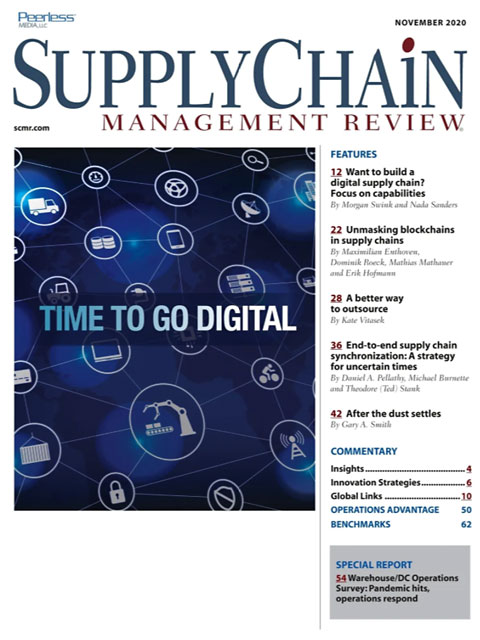Sorry, but your login has failed. Please recheck your login information and resubmit. If your subscription has expired, renew here.
November 2020
Supply chains have been in the spotlight like never before over the last eight months. That hasn’t always been a good thing. The perception, reinforced by shortages of products essential to our daily lives, is that supply chains were not up to the task and failed. The reality, as argued by MIT’s Yossi Sheffi in his new book, “The New (Ab)Normal: Reshaping Business and Supply Chain Strategy Beyond COVID-19,” is that supply chains performed as designed—they did what we expected them to do. Browse this issue archive.Need Help? Contact customer service 847-559-7581 More options
COVID-19 has swelled the e-commerce tidal wave that was submerging traditional retailing before the virus struck. During the pandemic, stay-at-home consumers switched to online buying in droves, and the 2020 roll call of bricks-and-mortar bankruptcies reads like a “Who’s Who” of retailing.
However, there is another side to this dramatic story. The pandemic has also unleashed a wave of innovation that is giving more impetus to the changes that are reshaping the retail business and its supporting supply chains.
As I describe in my new book, “The New (Ab)Normal: Reshaping Business and Supply Chain Strategy Beyond COVID-19,” the crisis is compressing innovation adoption cycles as retailers scramble to stay afloat in an ever-changing landscape. These efforts offer vital clues to the shape of retailing in a post-pandemic world.
Navigating new paths
During May and June 2020, the MIT Center for Transportation & Logistics conducted a survey of grocery shopping habits in the United States. The survey, part of a “Covid-19 Generational and Lifestyle Study,” elicited 1,320 responses. The survey focused on buying behavior, distinguishing between store shopping and various online modes such as home delivery, curbside pickup and locker pickup. Home delivery’s share of shopping increased from 13% to 31% of all buying trips. Of those individuals who shifted from in-store shopping to home delivery—the largest group to shift modes—31% stated they were likely to continue with home delivery.
SC
MR
Sorry, but your login has failed. Please recheck your login information and resubmit. If your subscription has expired, renew here.
November 2020
Supply chains have been in the spotlight like never before over the last eight months. That hasn’t always been a good thing. The perception, reinforced by shortages of products essential to our daily lives, is that… Browse this issue archive. Access your online digital edition. Download a PDF file of the November 2020 issue.COVID-19 has swelled the e-commerce tidal wave that was submerging traditional retailing before the virus struck. During the pandemic, stay-at-home consumers switched to online buying in droves, and the 2020 roll call of bricks-and-mortar bankruptcies reads like a “Who’s Who” of retailing.
However, there is another side to this dramatic story. The pandemic has also unleashed a wave of innovation that is giving more impetus to the changes that are reshaping the retail business and its supporting supply chains.
As I describe in my new book, “The New (Ab)Normal: Reshaping Business and Supply Chain Strategy Beyond COVID-19,” the crisis is compressing innovation adoption cycles as retailers scramble to stay afloat in an ever-changing landscape. These efforts offer vital clues to the shape of retailing in a post-pandemic world.
Navigating new paths
During May and June 2020, the MIT Center for Transportation & Logistics conducted a survey of grocery shopping habits in the United States. The survey, part of a “Covid-19 Generational and Lifestyle Study,” elicited 1,320 responses. The survey focused on buying behavior, distinguishing between store shopping and various online modes such as home delivery, curbside pickup and locker pickup. Home delivery’s share of shopping increased from 13% to 31% of all buying trips. Of those individuals who shifted from in-store shopping to home delivery—the largest group to shift modes—31% stated they were likely to continue with home delivery.
 SUBSCRIBERS: Click here to download PDF of the full article.
SUBSCRIBERS: Click here to download PDF of the full article.
SC
MR


Latest Supply Chain News
- Tech investments bring revenue increases, survey finds
- Survey reveals strategies for addressing supply chain, logistics labor shortages
- Israel, Ukraine aid package to increase pressure on aerospace and defense supply chains
- How CPG brands can deliver on supplier diversity promises
- How S&OP provides the answer to in-demand products
- More News
Latest Resources

 Explore
Explore
Business Management News
- Survey reveals strategies for addressing supply chain, logistics labor shortages
- How CPG brands can deliver on supplier diversity promises
- How S&OP provides the answer to in-demand products
- AI, virtual reality is bringing experiential learning into the modern age
- Tips for CIOs to overcome technology talent acquisition troubles
- There is still work to do to achieve supply chain stability
- More Business Management
Latest Business Management Resources

Subscribe

Supply Chain Management Review delivers the best industry content.

Editors’ Picks






